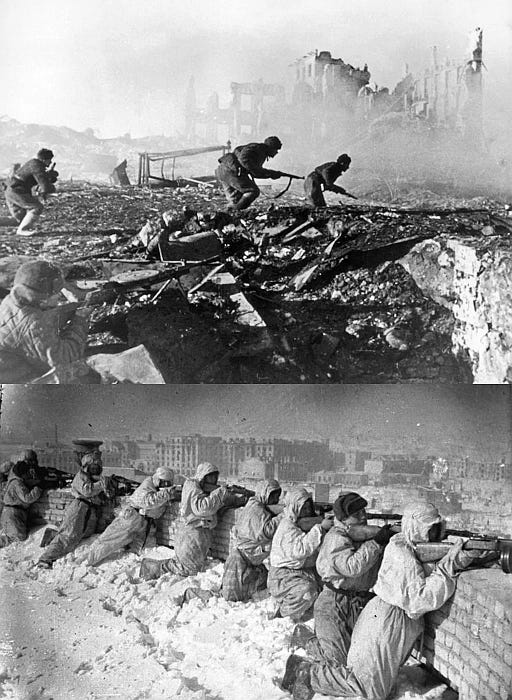The Mysteries of History (February 2 Edition)
Guadalupe Hidalgo, Battle of Stalingrad, and Idi Amin
“Those who cannot remember the past are condemned to repeat it.” — Spanish-American philosopher George Santayana, 1905
1848 — Treaty of Guadalupe Hidalgo
public domain image from wikimedia commons
The Mexican-American War ended on this date in 1848 when the Treaty of Guadalupe Hidalgo was entered into. The war’s losers, Mexico, ceded over half a million acres of land to the United States, territory that became six States (Arizona, California, Nevada, New Mexico, Texas, and Utah) as well as portions of two others (Colorado and Wyoming).
The United States paid $15 million for the land, but Mexico didn’t really want to sell, and certainly not at that bargain basement price; however, they were made “an offer they couldn’t refuse.”
Nine days earlier (as written up here), gold had been discovered in Coloma, California. Tens of billions of dollars worth of gold have been extracted from California paydirt since the acquisition of California (and the other “bonus” States and Statelets).
Questions: Who was Guadalupe Hidalgo? How much is $15 million in equivalent dollars today? Who was U.S. President at the time? What role did the man destined to become the next President have in the Mexican-American War? What position did Abraham Lincoln have at the time, and what did he have to say about this turn of events?1943 — Nazi Germany’s Russian Waterloo
public domain images from wikimedia commons
The German army’s siege of Stalingrad, Russia (now called Volgograd) went well for them at first. But they faced fierce resistance; and then winter came. On this date in 1943, two thirds of the way through World War 2, the last German soldiers in Stalingrad surrendered to the Russians. This was a major blow to the Nazis: The Battle of Stalingrad was a “Waterloo,” a turning point, for the Nazis, occurring approximately a year-and-a-half before the even more stunning and decisive blow they suffered with the Invasion of Normandy (“D-Day”) in June of 1944.
Questions: How long did the siege of Stalingrad last? How many died — how many German soldiers, how many Russian soldiers, how many Russian civilians? Why was Stalingrad so important to the Nazis? Why did the German military planners think they could prevail? How were the Russians able to overcome the Nazi onslaught? 1971 — Idi Amin Implodes Uganda
public domain images from wikimedia commons
On this date in 1971, Idi Amin, who had been head of the Uganda military for five years, took advantage of the absence of Milton Obote, the country’s leader, by declaring himself President. One of Amin’s acts of genocide and jingoism was to expel all Asians from Uganda. As a result, 60,000 Indians and Pakistanis fled the country, which led to economic collapse.
Five years later, in 1976, the meany Amin declared himself President for life. Yet, Amin was only President for another three years: In 1979 he had to flee his native country after picking a fight with neighboring Tanzania who, along with a force of exiled Ugandans, successfully resisted his belligerence, causing him to flee Uganda in a manner foreshadowing the absquatulation of Bashar al-Assad from Syria on December 8, 2024. Amin was given refuge by Saudi Arabia (where he died in 2003), similar to al-Assad being welcomed hospitably by his old crony Putin in Russia.
Questions: Why did Saudi Arabia welcome Amin? What did Amin do for the rest of his life? Who was the leader of Uganda immediately before and after Amin's rule? How many exiled Ugandans fought against Amin's forces along with the Tanzanians?








